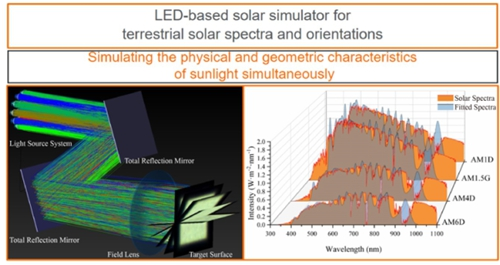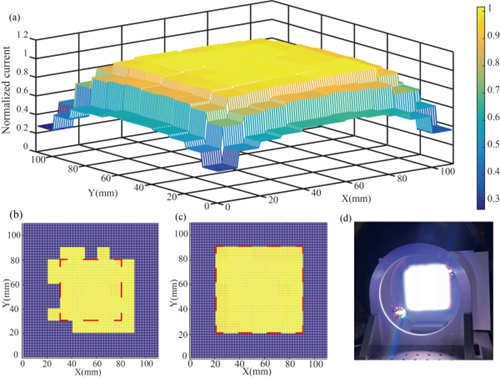Chinese Academy of Sciences makes progress in LED solar simulation technology
2022-04-12
Light-emitting diodes (LEDs) have gradually become a hot light source for solar simulators due to their high efficiency, environmental protection, safety and stability. At present, the LED solar simulator mainly realizes the simulation of 3A characteristics on a specific plane and the changing ground solar spectrum. It is difficult to simulate the geometric characteristics of sunlight under the requirement of a solar constant (100mW/cm2) illumination.
Recently, Xiong Daxi's team from Suzhou Institute of Biomedical Engineering and Technology, Chinese Academy of Sciences, designed a distributed high thermal conductivity single crystal COB package based on a high-power vertical structure narrow-band LED light source to achieve a stable output of high optical power density.
Figure 1 Graphical summary of the solar simulator

At the same time, a method of concentrating light with full aperture of high-power LED by using a super-hemispherical chiming lens is proposed, and a set of curved multi-source integral collimation system is built to complete the collimation and homogenization of the full-spectrum light source in the volume space range. . The researchers used polycrystalline silicon solar cells to conduct controlled experiments on outdoor sunlight and a solar simulator under equal conditions, verifying the spectral accuracy and azimuthal consistency of the solar simulator.
The solar simulator proposed in this study achieves class 3A illumination with 1 solar constant irradiance in a test plane of at least 5cm x 5cm. At the center of the beam, within the working distance of 5cm to 10cm, the irradiance volume spatial inhomogeneity is less than 0.2%, the collimated beam divergence angle is ±3°, and the irradiance time instability is less than 0.3%. Uniform illumination can be achieved within the volume space, and its output beam satisfies the cosine law in the test area.
Figure 2 LED arrays with different peak wavelengths

In addition, the researchers also developed arbitrary solar spectrum fitting and control software, which for the first time realized the simultaneous simulation of the ground solar spectrum and the solar orientation under different conditions. These characteristics make it an important research tool in the fields of solar photovoltaic industry, photochemistry, and photobiology.
Fig. 3 The irradiance distribution of the target surface perpendicular to the beam when the working distance is 100mm. (a) Normalized 3D model distribution of measured current values; (b) Distribution map of class A (less than 2%) irradiance inhomogeneity (yellow area); (c) Class B (less than 5%) irradiance inhomogeneity Distribution map of uniformity (yellow area); (D) real shot of light spot

The research results were published in Solar Energy under the title of LED-based solar simulator for terrestrial solar spectra and orientations.




